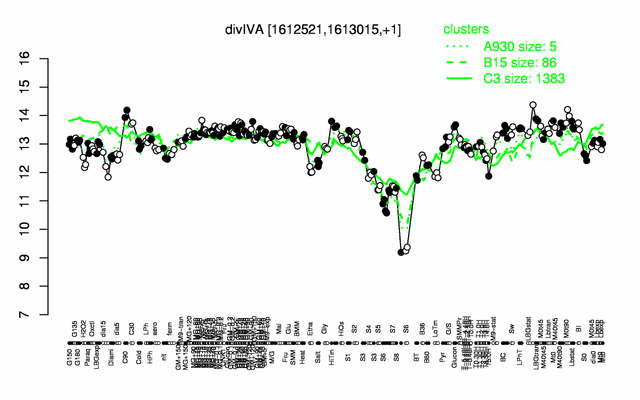Difference between revisions of "DivIVA"
| Line 97: | Line 97: | ||
** [[DivIVA]]-[[RacA]], [[DivIVA]]-[[DivIVA]] | ** [[DivIVA]]-[[RacA]], [[DivIVA]]-[[DivIVA]] | ||
** [[Maf]]-[[DivIVA]] {{PubMed|21564336}} | ** [[Maf]]-[[DivIVA]] {{PubMed|21564336}} | ||
| + | ** [[DivIVA]]-[[ComN]] {{PubMed|22582279}} | ||
* '''[[Localization]]:''' | * '''[[Localization]]:''' | ||
| Line 156: | Line 157: | ||
<pubmed> 19654604, 19884039 </pubmed> | <pubmed> 19654604, 19884039 </pubmed> | ||
==Original Publications== | ==Original Publications== | ||
| − | <pubmed>19654604, 19666580,9219999,19019154,15554965, 12368265,11445541,10835369,12511520,14651647, 19478798 ,19429628, 11445541, 9219999, 9045828 20352045 20502438 11886553 21564336 22108385 22457634 22517742</pubmed> | + | <pubmed>22582279, 19654604, 19666580,9219999,19019154,15554965, 12368265,11445541,10835369,12511520,14651647, 19478798 ,19429628, 11445541, 9219999, 9045828 20352045 20502438 11886553 21564336 22108385 22457634 22517742</pubmed> |
[[Category:Protein-coding genes]] | [[Category:Protein-coding genes]] | ||
Revision as of 13:59, 16 May 2012
- Description: cell-division initiation protein (septum placement), part of the Min system (with MinC, MinD, MinJ), Noc and the Min system ensure the efficient utilization of the division site at midcell in by ensuring Z ring placement
| Gene name | divIVA |
| Synonyms | ylmJ |
| Essential | no |
| Product | cell-division initiation protein |
| Function | septum placement |
| Interactions involving this protein in SubtInteract: DivIVA | |
| MW, pI | 19 kDa, 4.846 |
| Gene length, protein length | 492 bp, 164 aa |
| Immediate neighbours | ylmH, ileS |
| Get the DNA and protein sequences (Barbe et al., 2009) | |
Genetic context 
This image was kindly provided by SubtiList
| |
Expression at a glance PubMed
| |
Contents
Categories containing this gene/protein
cell division, membrane proteins, phosphoproteins
This gene is a member of the following regulons
The gene
Basic information
- Locus tag: BSU15420
Phenotypes of a mutant
Deletion of divIVA leads to filamentation and polar divisions that in turn cause a minicell phenotype. PubMed A divIVA mutant has a severe sporulation defect. PubMed
Database entries
- DBTBS entry: [1]
- SubtiList entry: [2]
Additional information
Filamentation is suppressed by mutations in minCD PubMed.
The protein
Basic information/ Evolution
- Catalyzed reaction/ biological activity: DivIVA is required for polar localisation of MinCD via MinJ. PubMed It also recruits RacA to the distal pole of the prespore PubMed.
- Protein family: gpsB family (according to Swiss-Prot)
- Paralogous protein(s): GpsB
Extended information on the protein
- Kinetic information:
- Domains: The first 60 amino acids constitute a lipid binding domain. PubMed
Multimerisation involves two coiled-coil motifs, one in the lipid binding domain, and the other one being present in the helical C-terminal domain PubMed.
- Modification:
- Cofactor(s): not known
- Effectors of protein activity: not known
Database entries
- UniProt: P71021
- KEGG entry: [3]
- E.C. number:
Additional information
Expression and regulation
- Operon: divIVA PubMed
- Sigma factor:
- Additional information:
Biological materials
- Mutant: divIVA::tet available from the Hamoen Lab
- Expression vector:
- lacZ fusion:
- GFP fusion: divIVA-gfp fusions available from the Hamoen Lab
- two-hybrid system:
- Antibody:
Labs working on this gene/protein
Leendert Hamoen, Centre for Bacterial Cell Biology, Newcastle upon Tyne, United Kingdom [4]
Imrich Barak, Slovak Academy of Science, Bratislava, Slovakia homepage
Your additional remarks
References
Reviews
Original Publications